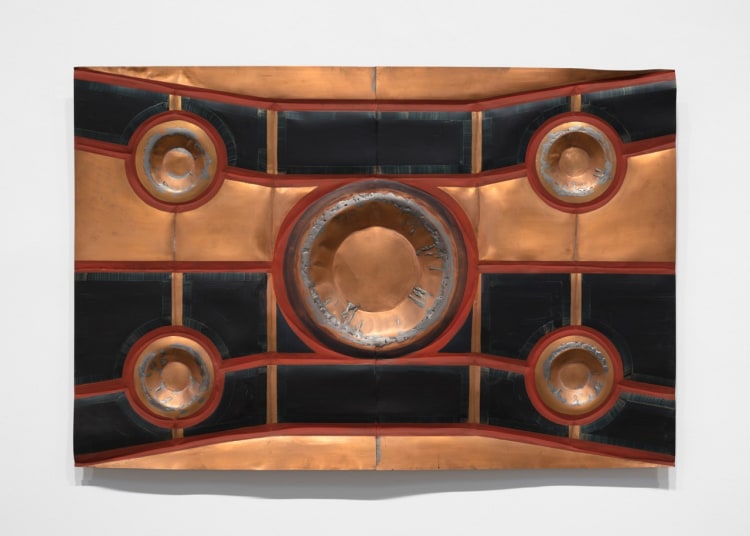
David Novros, Untitled, c. 1995
copper, gold mining pans, lead, oil paint
The kinesthetic relationship viewers encounter with painting has long been a preoccupation for David Novros. During a 9 month visit to Europe in 1963, Novros saw not only the Galla Placidia Mausoleum in Ravenna and the Scrovegni Chapel in Padua—amongst other examples of historic wall art—but also and most significantly the Alhambra in Granada, about which he said in a 2008 interview with Michael Brennan,
"It was going to the Alhambra that changed my view of what I wanted to be as a painter. Actually, that’s not accurate; it reunited me with my feelings for wall painting …(it) taught me that painting could be something other than a rectangle hanging on a wall in a museum or gallery, I saw for the first time how a painting didn’t even have to be made of paint."
In this exhibition we can experience the multivalent approaches to painting that are present in this artist’s long career. Not only are there works on canvas and watercolor on paper, but also painted copper, lead and iron, and ceramic pieces. Also included is a model that anticipates the integration of painting into a purpose built architectural environment, the porcelain, plaster, and acrylic Solar Model (2000). The four sides and open top interior recall an atrium in a Roman house. The interior walls of Romano-Campania houses typically contain wall frescos. Such fresco painting Novros is very familiar with and his “portable murals” relate strongly to this concept of painting as a situated experience or what he calls a “painted place” in the context of his own work. One of the multi-panel paintings here is Boathouse (2016), which was initially a commission for a specific place, a boathouse. The 7 polychrome panels have an overall size of 11 by 20 feet. Four L-shaped panels surround but do not entirely contain (there are spaces where the two U-shapes formed by the 4 panels don’t meet) three sequentially related internal and vertical rectangular panels imply movement and encourage a mobile viewing. The color shimmers where Murano paint is used, a paint that produces a pearlescent effect. A fixed and ideal viewpoint seems arbitrary in this circumstance and a passage from one side to the other of Boathouse along its length is as natural an encounter as passing along a wall—both physically involved, and a reading of changing pictorial units or events. The color is very complex, evolved on the surface in repeated layers, he has said, “Sometimes I paint one area of the painting for years—trying to find the ‘right’ light.”
SW (2009) is an approximately 12 × 8 feet multi-panel painting, implying a three sided enclosure, shaped like a half dome chapel alcove or large-scale votive painting with perspectival side panels—the associations multiply, yet it is very much a place in and of itself when approached. The color is earth red, pink, and black recalling raw fresco or plaster. The tonal relationships infer the passage of space, especially the echo of the curved top section in the dark shape below. The open horizontal brush-work in this painting indicates something that is always present in a Novros painting—a gestural application of paint that isn’t expressionistic, but which activates the surface. The linear design on the curved top section recalls Byzantine and Romanesque architectural space. NW (2019) is similarly comprised of multi-panels that are all congruent with each other and similarly suggests a curved alcove space with a different configuration; this time the panels are closer in tone and include resonant blues. Several watercolors on paper are presented, some unframed, that relate to panel paintings. Untitled (2018) for example directly corresponds to Phoenix (June-September 2018).
The open brush-work of SW is seen in a different form as glaze on the six shallow bowl shaped, ceramic pieces of Untitled c.1994. The grey and black color and combination of curved shape and gestural drawing is precise and spontaneous.
Amongst the works on metal, the oil painted lead and copper Untitled (c.1995) is manifestly physical and a particular shape; it is also a painting. It evokes conjoined mirrors, or a shield, something from antiquity rather than a minimalist object. Portable Cave (1975) the earliest work here is an iron, oil painted object, that forms a frontal, curved vertical space, like the votive and portable, early Italian painting, but in this case referencing the origins of not just painting on panels but painting itself in Paleolithic era caves.
Novros is not only a great colorist, iterations of shape within composition display an intuitive rather than systematic approach to color in relation to form and surface—these paintings determine an expansion of possibility for painting, and a reconnection with painting within architecture that is apart from tradition of easel painting. It is not the simple object emphasis of some abstract painting or the transfer of a plan to wall, as with Sol LeWitt, or an increase in scale for sublime effects, but a new coexistence of painting with architectural space and, the viewers kinesthetic experience of movement through that space.